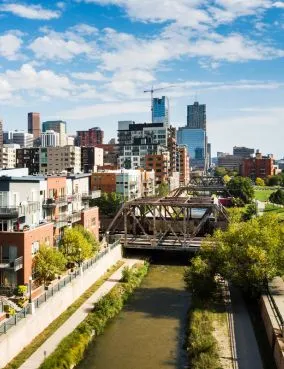Caroline Hayes left Seattle with excitement and hope. After years spent in constant motion, she needed stillness. “I wanted to live somewhere that feels peaceful and real,” Caroline said, her words soft like the drizzle falling over Edinburgh. Moving to Scotland from the USA gave her that chance. Scotland offers beauty, balance, and community. Its history, culture, and kindness attract more Americans each year.
The number of U.S. citizens moving there continues to rise. Good preparation makes it possible. Learn about visas, plan for housing, and review healthcare early. Each small step leads to a confident and rewarding move.
The following guide covers each step in order.
Why Are So Many Americans Considering Moving to Scotland from the USA?
The numbers tell a clear story. Wages stand still while housing prices move higher. Inflation is steady. Many people feel that daily life has become too expensive.
As a result, more Americans are looking abroad for balance and security. Around 5.5 million U.S. citizens now live overseas, according to Savvy Nomad. The number keeps growing every year.
Scotland, once a dream vacation spot, is becoming a real option. Its slower tempo and fair prices pull newcomers in.
Scots rate life 7.4 out of 10, above the OECD average. Fraser of Allander Institute says strong public services and social trust help make life there feel stable.
Healthcare is public. University fees stay reasonable. Side streets are lively and safe. Communities feel open and welcoming. More professionals now build their lives in Scotland rather than in London or Berlin.
Put simply, moving to Scotland from the USA means trading stress for steadiness. Life here feels measured, grounded, and full of quiet charm.

Related – What is the Difference Between Relocation vs. Moving?
What Makes Scotland Feel Stable in Uncertain Times?
While many European countries struggle with political divisions, Scotland projects a quieter sense of balance. Its social policies, renewable energy focus, and manageable pace of urban life attract Americans who feel burned out by the constant speed of U.S. life.
“People talk about work-life balance as if it’s a luxury,” says Dr Fiona Douglas, a sociologist at the University of Glasgow. “In Scotland, it’s part of our design, with shorter commutes, accessible healthcare, and an emphasis on time spent outdoors.”
For many relocating families, these differences are transformative. In Leith, renters pay close to £1,400 monthly for a two-bedroom flat. That is about half the rate of San Francisco’s housing market. The NHS provides healthcare with no extra fees or unexpected costs.
Even for those coming from major American cities, that stability feels revolutionary.
How Do Americans Obtain Visas for Scotland?
The practical side of moving to Scotland from the USA has become far simpler than most expect. Moreover, while Scotland is part of the United Kingdom, its immigration pathways are administered through the UK Home Office.
For most Americans, relocation falls under one of five main categories –
- Skilled Worker Visa – For professionals joining UK companies with pay from £38,700.
- Global Talent Visa – For top academics, digital experts, and artists recognized for significant global impact.
- Student Visa – A route increasingly popular among younger Americans drawn to universities like Edinburgh and St Andrews.
- Family Visa – For those joining a British or settled partner.
- Investor and Innovator Visas – For entrepreneurs seeking to establish or fund a UK-based business.
Home Office figures from 2024 revealed a 37% jump in U.S. visa applications since 2020. Moreover, the Skilled Worker visa made up the majority. Meanwhile, Scotland continues to attract professionals in renewable energy, healthcare, and university research.
What Is Life Like After Arriving in Scotland?
Adjusting to life in Scotland goes far beyond signing forms. The days move at a gentler pace, manners are layered with quiet courtesy, and community feels both close and genuine.
“The first thing I noticed was how conversations stretch,” Caroline recalls. “People don’t rush you. They ask about your day, and they mean it.”
Public transport is reliable, and cities are easy to walk in. Also, the Scottish government offers integration help through local councils. Together, these programs guide newcomers smoothly.
Soon, many find belonging in community groups like gardening clubs or ceilidh classes. Broadband across Scottish cities offers strong and reliable connections for remote workers.
Edinburgh ranks among Europe’s top ten hubs for digital nomads, with fast internet and vibrant co-working spaces, ideal for anyone moving to Scotland from the USA.
What Are the Visa Requirements for Moving to Scotland from the USA?
Americans moving to Scotland must first apply for a UK visa. The type of visa depends on whether they plan to work, study, or join their family. After that, the relocation process becomes smoother.
Below are the common requirements applicants should prepare before applying –
- Valid U.S. passport with at least six months’ validity
- Recent passport-size photographs
- Completed online visa application form
- Proof of employment or a job offer letter for the Skilled Worker Visa
- Proof of admission from a Scottish university for the Student Visa
- Marriage or family documents for Family Visa applicants
- Bank statements or proof of funds showing financial stability
- Salary slips or tax proof for job verification
- Accommodation proof, like a lease or letter
- An English certificate, such as IELTS, if needed
- Payment receipt for visa fee and health surcharge
Additional Notes – Most visas are processed within three to eight weeks. Then a biometric appointment in the U.S. may be required. After approval, the visa grants entry to Scotland and can later be renewed or adjusted.
How Do Newcomers Adjust Emotionally to Life in Scotland?
Every move abroad involves a recalibration of identity. For Americans arriving in Scotland, that process often unfolds quietly, as the weather hums with rain and the light changes by the hour.
Meanwhile, psychologists studying expatriate adaptation note that cultural transition takes an average of six months. Moreover, Scotland’s smaller scale helps, as distances are short and people greet you twice, once when you arrive and again when they’ve decided you’re staying.
“I expected homesickness,” said Jason Miller, an IT consultant from Boston now based in Glasgow. However, “instead, I found routine, the same café, the same walk to the River Clyde. Eventually, it grounded me.”
For many, that routine becomes the emotional foundation of belonging.
What Does It Really Cost to Live in Scotland?
Relocation is an economic equation. While living costs are generally lower than in major U.S. cities, they vary by region. Housing and transport cost the most. However, public services ease some of the burden. Next, essentials like food and utilities stay affordable. Compared with big U.S. cities, prices feel lighter. Yet, many newcomers find life in Scotland more balanced.
A realistic budget for a single professional moving to Scotland from the USA includes –
| Expense | Average Monthly Cost (GBP) |
| Rent (1-bedroom city centre) | £1,200 |
| Utilities (electricity, gas, internet) | £200 |
| Groceries | £300 |
| Public transport | £65 |
| Health surcharge (annual) | £624 |
| Leisure & dining | £200 |
The typical monthly budget for an expat ranges from £2,000 to £2,200, equal to about $2,500 to $2,800.
The NHS surcharge provides access to public healthcare. Moreover, it removes the need for private insurance or unexpected medical bills. Meanwhile, higher education for international students costs around £22,000 per year. Overall, that amount is roughly half the price of most American colleges.
For retirees, the UK Pension Age of 66 allows access to healthcare and benefits, provided legal residency requirements are met.
What Should Families Expect from Education in Scotland?
Families moving to Scotland from the USA often begin with one question. First, what will school be like for the children? Then, the answer is calm and steady. In Scotland, the Curriculum for Excellence shapes learning. Finally, curiosity and compassion stay at its core.
Moreover, teachers help students learn to think independently. In contrast, testing feels lighter, and the pace allows time to learn deeply.
In larger cities, international schools remain available. Yet, many American parents choose local state schools instead. They find warmth there. They find teachers who know their students well.
At the university level, opportunity grows wider. St Andrews remains one of the world’s top 100 universities (Top Universities). During the same period, American enrollment increased by 24%.
At the same time, Glasgow and Edinburgh Napier built programs that welcome and support international learners.
Education here moves slowly, but with purpose. It values understanding more than speed, and that difference changes everything.
Also read – The Ultimate Guide for Student Relocation
How Do Americans Adapt to Scottish Culture?
Settling into Scotland’s pace feels both calming and unfamiliar. At first, people lead with kindness rather than bluntness. Gradually, rain becomes a rhythm, and soon, resilience a quiet habit.
The Scottish sense of humor, understated and self-deprecating, takes time to decode. So do phrases like “wee dram” or “aye, right.” Yet beneath the wit lies a genuine warmth.
Locals gather in warm pubs. Then, on weekends, they head for the hills. Later, they return to celebrate poetry, film, and folk music. Finally, in August, the Edinburgh Fringe fills the city with color and sound.
Can Remote Workers Thrive in Scotland?
For many Americans, relocation has less to do with finding new jobs and more with finding a new balance. Remote work has untethered workers from office-bound lives, enabling them to live and work globally.
In Scotland, government-backed initiatives such as Scotland’s Digital Strategy and the Rural 5G Connectivity Project make this lifestyle sustainable even in smaller towns. Moreover, broadband coverage now reaches 96% of households. Scotland has the highest percentage of remote jobs among UK regions, at an average of 4.11% compared to England’s ~3.22% (Virtual College).
“Scotland offers what remote professionals crave: space, connectivity, and community,” says Sarah Kendall, a relocation consultant in Edinburgh. “It’s not only about cost; it’s about coherence.”

Recommended read – What is the Anticipated Impact of Remote Work on Job Market Trends?
How Does the Scottish Landscape Influence Well-Being?
Beyond policy and plans, Scotland reveals its soul through the land. The Highlands rise in quiet strength. Lochs reflect shifting skies. Even the wind moves like a gentle voice.
The University of Stirling reported that moments spent outdoors reduce stress nearly a third more than life surrounded by concrete.
For Americans weary of noise and division, this calm feels like repair. Slowly, the land steadies the mind. Then peace returns, soft and steady, like the light across the hills.
What Challenges Should You Expect When Moving to Scotland from the USA?
Every relocation carries friction. At first, the Scottish winter feels long to new arrivals, then the paperwork feels heavy, and finally, politeness sometimes feels like distance.
In Scotland, banks like Lloyds, Barclays, and RBS lead the market. U.S. credit histories don’t transfer, and mobile plans need a local address. During those first months, persistence and adaptability become essential.
However, community ties form quickly. Moreover, expat groups such as Americans in Scotland and local councils’ newcomer programs provide both logistical and emotional support.
Daniel’s Relocation from Texas to Scotland with Relo.AI
Daniel R. is a software engineer from Texas who decided to move to Scotland in search of a slower pace of life and better work balance. The decision felt bold but necessary. At first, he struggled to find suitable housing near Edinburgh’s tech corridor.
Relo.AI then connected him with verified local agents who helped him secure a modern flat in Stockbridge, one of the city’s most livable neighborhoods.
Soon after, Daniel faced another challenge with opening a bank account and understanding Scotland’s tax system. Fortunately, with Relo.AI’s support, he connected with bilingual advisors who explained the local regulations clearly and then helped him complete his financial setup without delays.
Reflecting on the move, Daniel says, “Relo.AI made everything simple. I didn’t feel lost at any point in the process.”
His story shows how expert guidance and smart technology can turn the challenge of moving to Scotland from the USA into a calm and confident new beginning.
Let Relo.AI Guide Your Move to Scotland the Right Way
The first steps of moving to Scotland from the USA include visas, housing, and financial planning. Healthcare, transport, and cultural adjustment also need early attention. Scotland offers charm and opportunity, but preparation makes the transition smooth and stress-free.
At Relo.AI, we understand every stage of the move. Moreover, we know what life in the U.S. feels like before relocation and what awaits you in Scotland afterwards. Therefore, our role is to connect those two worlds through clear planning, guidance, and dependable local support.
First, securing housing, setting up healthcare, handling visa documentation, and coordinating shipments are all managed with care. Then, you focus on building your new life in Scotland. Finally, relocation should bring excitement and confidence, not stress or confusion.
If you are planning your move to Scotland, schedule a FREE consultation with us now.
You focus on Scotland. Relo.AI handles the move.
Wrapping Things Up!
Moving to Scotland from the USA demands focus and commitment. There are details to manage, from housing to healthcare and banking. Still, the effort leads to calm, balance, and a quieter rhythm of life. Scotland offers more than a new address. It promises a slower rhythm of life, strong public systems, and a sense of belonging grounded in shared values and tradition. At first, the rain and routines may take adjusting to, but comfort soon replaces uncertainty.
A new life in Scotland can bring calm, clarity, and a profound sense of home.











